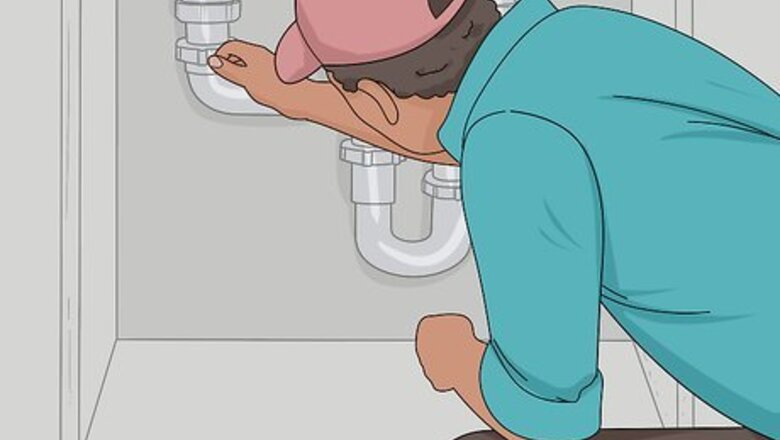
views
Positioning and Measuring the Pipes
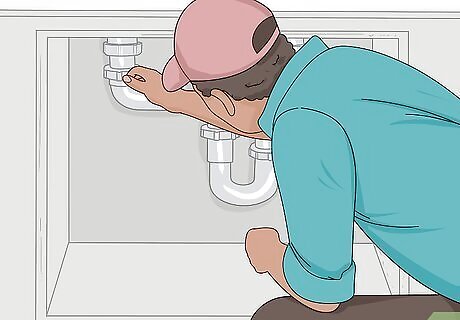
Have a plumber install a waste pipe in the wall if you don’t already have one. Contact plumbers in your area and tell them where you want to install a sink. Get price quotes from each plumber and choose the one that’s within your budget. Allow the plumber to run a new waste pipe from the wall where you want the sink to the main waste line in your home. Waste pipes run through your entire home and connect to underground sewage lines to get rid of dirty water. Don’t attempt putting in a new waste line yourself since you could be exposed to sewage.
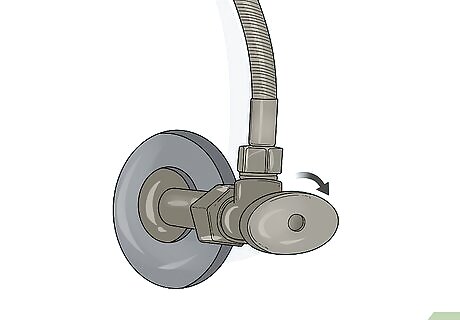
Turn off the water supply to the faucet if it’s connected. Go underneath the sink basin and look for 2 valves that control the hot and cold water. Rotate each handle clockwise as far as you’re able to shut off the water. Avoid turning on the faucet while you’re working since there may still be a little water left in the pipes. If you haven’t installed a faucet yet, then you don’t need to turn off the water connections.
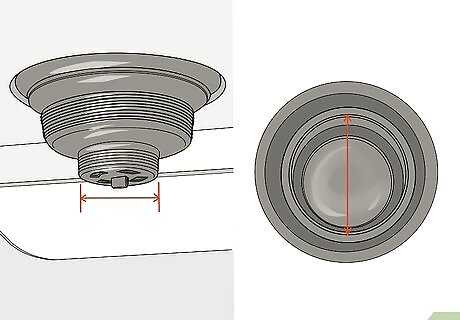
Measure the inner diameter of the waste pipe and drain. Hold a tape measure against the end of the waste pipe so “0” lines up with the inside wall of the pipe. Pull the tape measure horizontally across the pipe to the inside wall on the opposite side. Then locate the threading on the bottom of the drain underneath the sink basin. Use a tape measure to find the diameter between the threadings. Write down the measurements so you don’t forget them. Usually, the diameters of the drain and waste pipe are either 1 ⁄4 or 1 ⁄2 inches (3.2 or 3.8 cm). If you’re replacing an old drain trap, save it so you can ensure you get pipes that are the same size.
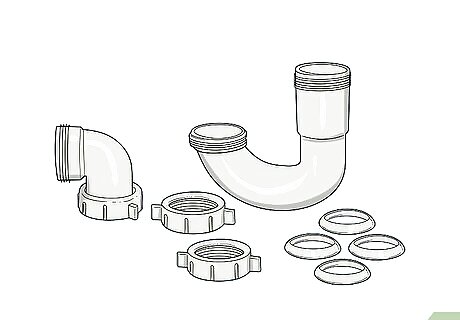
Buy a P-trap installation kit that matches the diameter of the drain. Look at your local home improvement or hardware store for a premade kit for sink P-traps. Choose a kit that contains pipes with the same diameter as the bottom of the drain. Opt for PVC or ABS pipes, which are both types of hard plastic that won’t corrode, and they’re easiest to maintain. Make sure the kit contains a J-pipe, trap arm, tailpiece, tapered and flange washers, and slip nuts. J-pipes are shaped like the letter J with one side taller than the other. Trap arms are pipes that have one straight end and one with a 90-degree bend. Tailpieces are straight pieces of pipes that have a 1 flared end and 1 unflared end. Slip nuts are round plastic pieces with threading that fit over rubber washers and pipe connections to prevent leaks. If you’re unable to find a kit, you can also buy all of the pieces individually.Tip: If the drain is larger or smaller than the waste pipe, purchase a trap adapter fitting that screws onto the waste pipe so you’re able to attach a pipe that’s differently sized.
Installing the Trap on the Waste Line
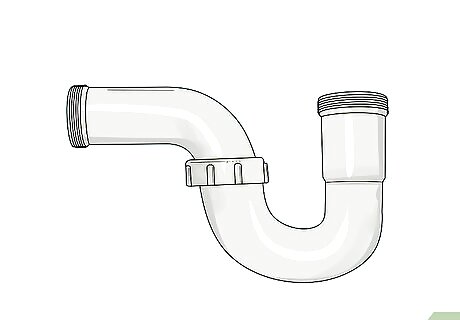
Screw the J-pipe onto the trap arm to make the P-trap. Hold the J-pipe so the openings point up and the shorter side is on the right side. Position the angled opening of the trap arm over the short end of the J-pipe so the threadings line up. Screw the plastic nut on the trap arm loosely so the J-pipe can swivel around without falling out. Avoid tightly screwing the pipes together yet since you may need to adjust the angle of the J-pipe later on. Do not apply pipe glue or cement around the threadings on any pipe connections since you won’t be able to unscrew them. If you use glue, then you will need to saw the pipes whenever you make repairs.
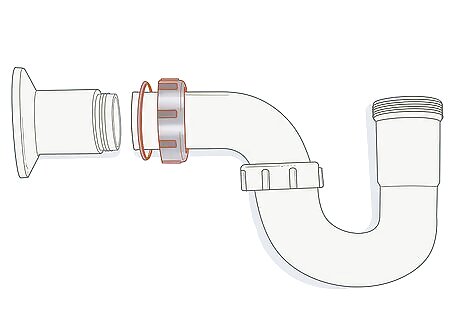
Slide a slip nut and washer onto the trap arm so the threading faces out. Take one of the plastic slip nuts from the P-trap kit and position it over the straight end of the trap arm. Make sure the threadings on the nut point toward the straight end. Then slide a tapered washer onto the pipe so the tapered side points toward the end of the pipe. Slide them about 2 inches (5.1 cm) down the pipe’s length. If you put the washers on with the tapered side facing in, then the pipes may leak when water runs through them.Variation: If the inner diameter of the drain and the waste pipe were the same, use a flanged washer instead. Put the larger end of the flange inside of the trap arm so the wider end is flush with the pipe.
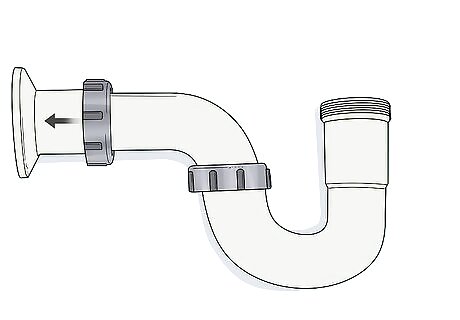
Push the trap arm into the waste pipe so the J-pipe lines up with the drain. Hold the P-trap with the curved portion of the pipe pointing down. Slowly push the straight end of the trap arm into the waste pipe. Continue pushing the trap arm deeper into the pipe until the opening on top of the J-pipe is directly underneath the drain in the sink basin. Rotate the J-pipe if you need to. If the waste pipe is the same diameter as the pipe, then screw the slip nut into the waste pipe right away.
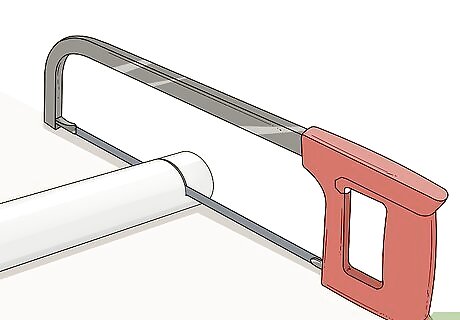
Cut the end of the trap arm with a hacksaw if it extended past the drain. Measure the distance from the opening in the J-pipe to where it lines up vertically with the drain. Pull the trap arm out from the waste line and measure in from the straight end to mark your cut. Hold the pipe still with your nondominant hand and slowly make a straight cut through it with a hacksaw. Throw away any pipe you removed from the trap arm. Avoid cutting the pipe at an angle, or else it will not fit properly and could cause leaks. Slide the slip nut and washer further down the trap arm so you don’t cut it off.
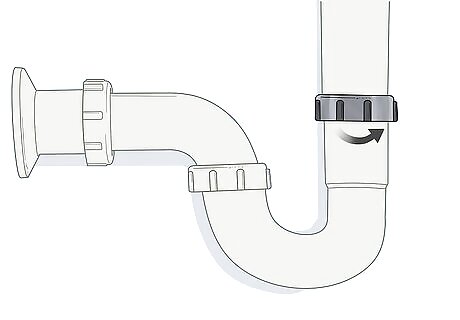
Screw the trap arm onto the threading on the waste pipe. Slide the trap arm back into the waste pipe and push it in until the top opening lines up with the drain. Slide the slip nut and washer over the pipe connection and onto the waste pipe’s threading. Turn the slip nut clockwise to tighten until you don’t feel any more resistance. Don’t tighten the nut if you feel any resistance since you could crack the plastic and cause a leak.
Sizing the Tailpiece
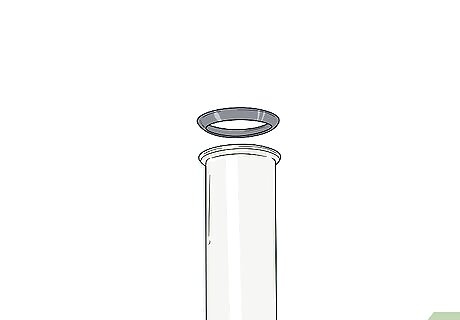
Put a flange washer in the flared end of the tailpiece pipe. Find the long section of straight pipe in your P-trap kit and look for the end that has a flared rim. Slide the narrow end of a flange washer into the end of the pipe so the wider end sits on the rim. Make sure the washer forms a tight seal around the edge so it doesn’t leak. If you’re working on a bathroom sink, look for a long cylindrical PVC or metal coming straight down from the drain, which could be a pre-installed tailpiece pipe. If your sink has one, you can skip this step.
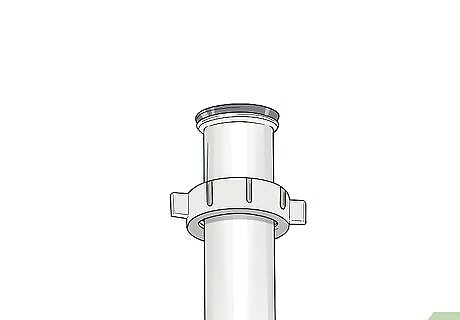
Push a slip nut onto the flared end of the tailpiece so the threading faces out. Take a plastic slip nut from the P-trap kit and place it around the tailpiece. Slide it down about 1 inch (2.5 cm) so you can still see the end of the pipe. Make sure the threading faces the flared end of the tailpiece, or else you won’t be able to screw it on. You don’t need to use a tapered washer for this slip nut.
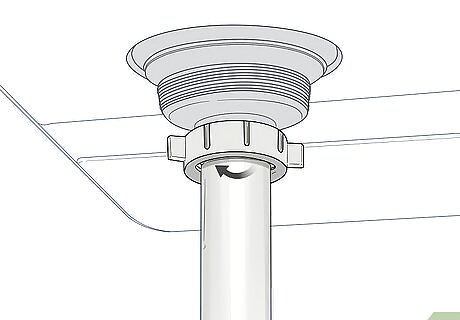
Screw the slip nut onto the bottom of the sink drain. Press the flared end of the tailpiece against the threading on the bottom of the drain. Ensure that the rim of the flange washer stays between the pipe and the drain. Slide the slip nut over the seam and turn it clockwise onto the threading. Continue screwing it in until it’s hand-tight. Be careful not to overtighten the nut if you feel resistance since you could crack the plastic.Variation: If your sink has 2 basins, screw a T-connection onto the bottom of the tailpiece so the opening faces the second drain. Run another tailpiece from the second drain to the T-connection in the same way.
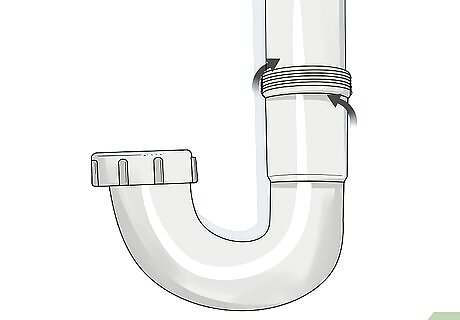
Rotate the J-pipe so it lines up with the bottom of the tailpiece. Turn the J-pipe around until it touches the tailpiece before tightening J-pipe’s slip nut. Make sure the bottom of the tailpiece extends into the flared opening of the J-pipe by about 1 inch (2.5 cm). Try to push the pipes together to see if you’re able to get a tight fit. Don’t try to bend or force the pipes together since you could crack or damage the connections.
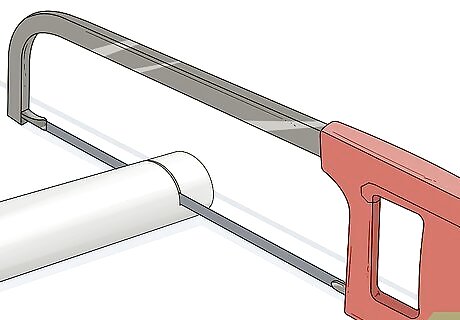
Remove and trim the tailpiece with a hacksaw if it extends past the J-pipe. Mark 1 inch (2.5 cm) below where the J-pipe intersects on the tailpiece. Unscrew the slip nut connecting the tailpiece to the drain and remove the pipe. Set the pipe on a sturdy surface and make a straight cut along your mark with a hacksaw. Work slowly to ensure you don’t damage the pipe. Screw it back onto the drain to check your fit. Be careful when sawing through pipes since they could roll around and cause the blade to slip.
Connecting and Testing the Drain
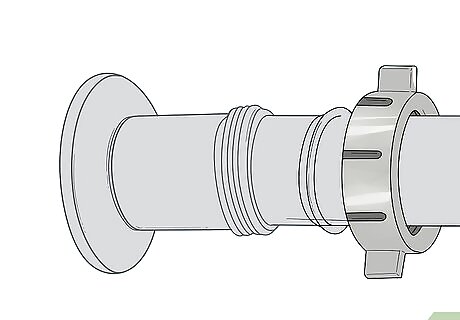
Add a slip nut and tapered washer to the bottom of the tailpiece. Push a slip nut up onto the straight end of the tailpiece. Make sure the threading points down toward the J-pipe. Then put a tapered washer on the pipe so the tapered side points down as well. Putting the washer on backward causes the pipes to leak.
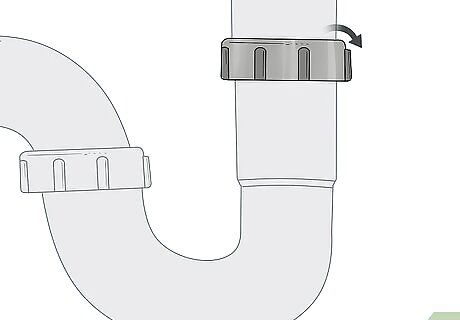
Screw the bottom of the tailpiece onto the J-pipe. Slide the end of the tailpiece into the top hole on the J-pipe. Slide the washer and slip nut tightly against the pipe’s seam so you can screw them into the J-pipe’s threading. Turn the slip nut clockwise until it’s hand-tight. If your sink has 2 basins and you had to use a T-connection, screw the bottom of the T-connection into the J-pipe instead.Warning: Stop screwing in the slip nuts if you feel resistance since they could crack and cause leaks.
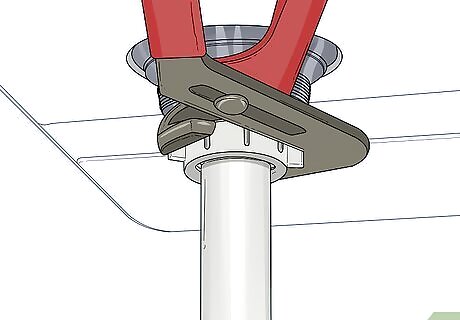
Tighten all of your connections by a quarter turn with a wrench. Grip the slip nut around the pipe connection in the jaws of a wrench and slowly rotate them a quarter turn clockwise. If you feel any resistance while you’re tightening them, stop turning them so they don’t break.
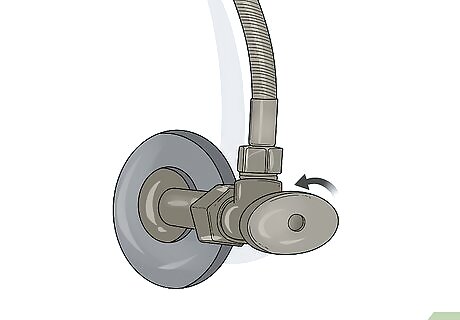
Turn on the water to test your drain assembly. Rotate the water supply valves counterclockwise as far as they can go to turn the water back on in your faucet. Plug the sink and fill half the basin with water. Pull the plug out and watch for any leaks coming out from the pipes. If you notice leaks, turn off your water and take the pipes apart to check if the nuts are tight and the washers are installed correctly. Have a bucket and towels ready in case there’s a leak.



















Comments
0 comment